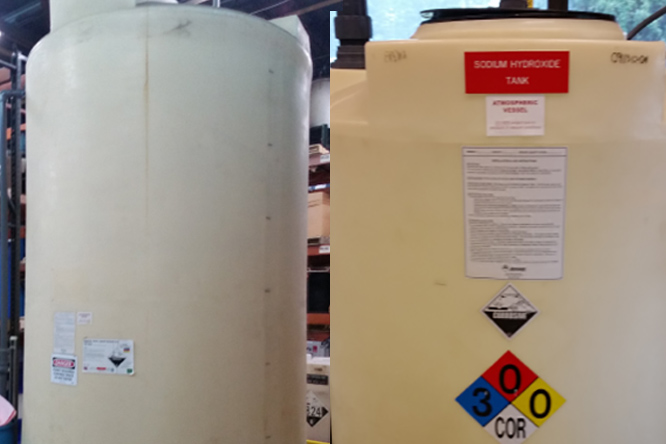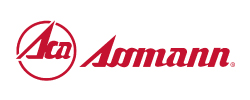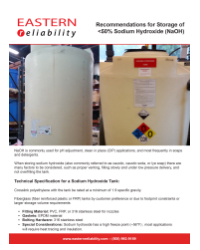Recommendations for Storage of <50% Sodium Hydroxide (NaOH)
NaOH is commonly used for pH adjustment, clean in place (CIP) applications, and most frequently in soaps and detergents.
When storing sodium hydroxide (also commonly referred to as caustic, caustic soda, or lye soap) there are many factors to be considered, such as proper venting, filling slowly and under low pressure delivery, and not overfilling the tank.

Technical Specification for a Sodium Hydroxide Tank:
Cross-link polyethylene with the tank be rated at a minimum of 1.9 specific gravity.
Fiberglass (fiber reinforced plastic or FRP) tanks by customer preference or due to footprint constraints or larger storage volume requirements
- Fitting Material:
PVC or 316 stainless steel for nozzles - Gaskets:
EPDM material - Bolting Hardware:
316 stainless steel - Special Considerations:
Sodium hydroxide has a high freeze point (~56°F) ; most applications will require heat tracing and insulation
Secondary Containment
All end users should check local regulations to meet secondary containment requirements. Containment must be adequate in capacity and suitable for sodium hydroxide. By accepting the delivery of the tank, the customer accepts full responsibility for providing appropriate and adequate containment for the stored material. Eastern Reliability offers a variety of secondary containment basins.
Connections
All connections below liquid level must prevent chemical from contacting tank wall cross section. Bulkhead style connections can be used on tanks 2,000 gallons and below. Tanks above 2,000 gallons, the sidewall connections should be stainless steel construction (flange style fittings are not recommended). Sidewall connections should be installed a minimum of 7" above the tank floor. Internal siphon drains can be used if required. Sidewall connections should be kept to a minimum amount and should be placed no closer than 22° apart. Whenever possible, sidewall connections should not be greater than 3". There are no restrictions on dome fittings.
Sidewall connections should be installed a minimum of 7" above the tank floor. Internal siphon drains can be used if required. Sidewall connections should be kept to a minimum amount and should be placed no closer than 22° apart. Whenever possible, sidewall connections should not be greater than 3". There are no restrictions on dome fittings.
Flexible Hoses or Expansion Joints (not required for FRP tanks)
Flexible hoses or expansion joints must be used on all lower 1/2 sidewall connections. A lightweight isolation valve is permitted prior to the flexible joint. Nipple and valve weight must not exceed 8 lbs.
All piping must be supported independent of tank. Pipe supports must be installed after the flexible joint, to allow the tank to expand and contract under normal service conditions. Polyethylene tanks expand and contract both laterally and vertically; expansion hose or joint must accommodate for this expansion.
Tank must maintain atmospheric pressure. Vents must be sized for a minimum of two times the largest inlet or outlet port for pneumatically filled tanks. Pump fill tank’s vent should be a minimum of one and a half times larger than the largest fill or discharge point. Adequate venting must always be maintained. Under no circumstances should tank be placed under pressure or vacuum conditions.
Sodium Hydroxide
Sodium hydroxide must not exceed 180°F at delivery and 150°F during storage. When practical, tank should be kept from direct sunlight to avoid excessive heat.
Excessive heat will degrade the chemical and will accelerate chemical reaction with tank materials. Heat will also cause additional off gassing and additional odors. HCl storage sometimes requires an accompanying Sodium hydroxide (NaOH) scrubber tank for vent odor scrubbing to prevent excessive odors.
Delivery
Deliveries must be regulated. Maximum delivery pressures must not exceed 12 PSI. Ideally, fumes should be vented back into delivery truck during offloading of chemical. Under no circumstances should tank be placed under pressure or vacuum conditions.


